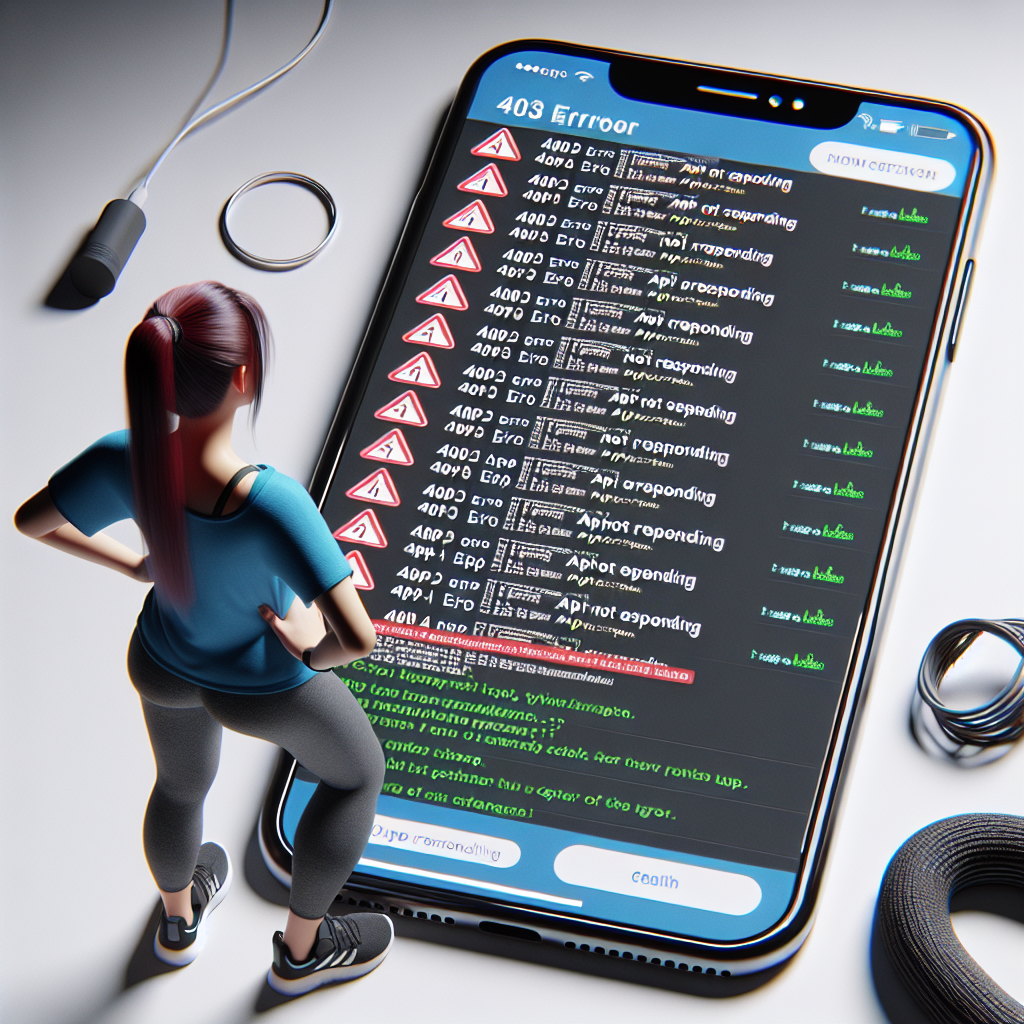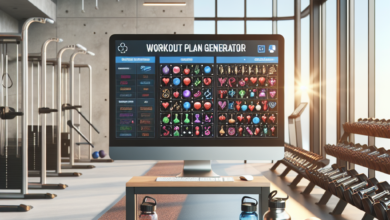Why Is Your Fitness App Not Working? Fix It Now!

Imagine gearing up for your morning workout, ready to log your progress, but your fitness app decides to crash. Frustrating, right? *Fitness apps* have revolutionized how we approach fitness, offering a plethora of features from tracking workouts to providing personalized training plans. However, they are not without their flaws. Many users encounter issues such as app crashes, inaccurate tracking, or even data loss.
One common reason your app might not be working is *software bugs*. Developers continually update apps to fix these glitches, but sometimes new updates can also introduce new problems. Another potential issue could be *compatibility*. If your device’s operating system is outdated, it might not support the latest version of the fitness app.
Additionally, *network problems* can disrupt app functionality. Many fitness apps require a stable internet connection to sync data or stream workout videos. If your connection is spotty, the app may not perform as expected. Lastly, *user errors* such as incorrect settings or permissions can also cause problems. Double-checking these settings might resolve the issue more often than you think.
Understanding these common issues is the first step to resolving them. Stay tuned as we delve into more specific problems and their solutions. For more expert tips and advice, Explore More at Muscle Theory.
Common Reasons Fitness Apps Fail

When your fitness app is not working, it can be due to a variety of common reasons. Understanding these can help you troubleshoot and get back on track more quickly. Here are some of the most frequent culprits:
- *Software Bugs*: These are the most typical issues. Bugs can cause apps to crash, freeze, or behave unexpectedly. Developers are constantly working to fix these, but no app is immune.
- *Incompatibility Issues*: If your device’s operating system is outdated, it might not support the latest version of the fitness app. Always ensure your device software is up to date.
- *Network Problems*: Many fitness apps require a stable internet connection for data syncing or streaming workout videos. A poor or unstable connection can significantly affect the app’s performance.
- *Storage Limitations*: Fitness apps, especially those that store a lot of data like videos and progress logs, require ample storage space. If your device is running low on storage, it can hinder the app’s functionality.
- *User Errors*: Sometimes, the problem lies in incorrect settings or permissions. Double-check that the app has the necessary permissions to access your device’s features.
- *Battery Optimization Settings*: Some devices have aggressive battery optimization settings that might limit the app’s background activity, causing it to malfunction.
By identifying these common reasons, you can take steps to correct them and improve your app’s performance. In the following sections, we will explore specific solutions to these problems, ensuring that your fitness journey remains uninterrupted.
How to Troubleshoot Fitness App Problems

Troubleshooting fitness app problems can feel daunting, but with a structured approach, you can often resolve issues quickly. Here’s a step-by-step guide to help you get your fitness app back on track:
- *Restart the App*: Sometimes, simply closing and reopening the app can resolve minor glitches. Ensure it’s completely closed and not running in the background before restarting it.
- *Update the App*: Developers frequently release updates to fix bugs and improve performance. Check for updates in your device’s app store and install any available updates.
- *Clear Cache*: Over time, apps accumulate cache that can cause performance issues. Go to your device’s settings, find the app, and clear its cache to free up resources.
- *Check Internet Connection*: Fitness apps often rely on a stable internet connection. Ensure you have a strong Wi-Fi or mobile data connection. If needed, switch to a different network to see if the issue persists.
- *Reinstall the App*: If the problem continues, uninstalling and reinstalling the app can help. This can resolve deep-rooted issues that simple updates cannot fix. Remember to back up any important data before uninstalling.
- *Review Permissions*: Ensure the app has all the necessary permissions to access your device’s features like GPS, camera, and storage. Go to your device’s settings to review and grant the required permissions.
- *Free Up Storage*: Check your device’s storage and delete unnecessary files or apps. Fitness apps need adequate storage to function correctly, especially those with multimedia content.
- *Contact Support*: If none of the above solutions work, reach out to the app’s customer support. Provide them with detailed information about the issue and any steps you’ve already taken. They can offer specific solutions or escalate the problem to the development team.
By following these troubleshooting steps, you can often resolve common fitness app issues and get back to your workout routine without much delay. In the next section, we’ll discuss preventative measures to ensure your app continues to perform optimally.
Tips for Improving Fitness App Performance

Ensuring your fitness app runs smoothly is crucial for maintaining your workout routine and achieving your fitness goals. Here are some practical tips to improve your fitness app’s performance:
- *Regularly Update the App*: Keeping your app updated ensures you have the latest features and bug fixes. Developers often release updates to improve performance and security, so make it a habit to check for updates frequently.
- *Optimize Device Performance*: Close unused apps running in the background to free up resources. Regularly restart your device to clear temporary files and refresh system performance.
- *Maintain Sufficient Storage*: Fitness apps, especially those with multimedia features, require ample storage. Regularly delete unnecessary files, apps, and media to ensure enough space for your fitness app to function optimally.
- *Stable Internet Connection*: Many fitness apps rely on an internet connection for features like live classes, progress syncing, and updates. Ensure you have a stable Wi-Fi or mobile data connection to avoid disruptions.
- *Optimize Battery Usage*: Some fitness apps can drain your device’s battery quickly. Check your app settings for any battery-saving options, and turn off unnecessary notifications that may consume power.
- *Regularly Clear Cache*: Over time, cache can build up and slow down app performance. Periodically clear the app cache from your device settings to ensure smooth operation.
- *Manage App Permissions*: Review the app permissions to ensure it has the necessary access to your device’s features such as GPS, camera, and storage. However, disable any permissions that are not essential to reduce unnecessary resource usage.
- *Use Lightweight Versions of the App*: Some fitness apps offer lightweight versions that consume fewer resources. If your device struggles with the full version, consider switching to a lighter version if available.
Implementing these tips can significantly enhance the performance of your fitness app, ensuring a seamless and effective workout experience. Up next, we’ll explore some of the best fitness apps currently available, so you can make an informed choice for your fitness journey.
Alternative Solutions for Fitness Tracking

When your fitness app isn’t performing as expected, it might be time to explore alternative solutions for tracking your fitness journey. Here are some viable options:
- *Wearable Fitness Trackers*: Devices like Fitbit, Garmin, and Apple Watch offer comprehensive tracking capabilities without relying on your phone. These wearables can monitor your heart rate, sleep patterns, steps, and even specific workouts, providing detailed insights into your fitness progress.
- *Manual Logging*: Sometimes, old-school methods can be just as effective. Use a fitness journal or a simple spreadsheet to log your workouts, meals, and progress. This approach allows for personalized tracking and can be tailored to your specific goals.
- *Smart Home Gym Equipment*: Modern home gym equipment often comes with built-in tracking features. Treadmills, stationary bikes, and rowing machines from brands like Peloton and NordicTrack offer integrated screens and software that track your performance and provide real-time feedback.
- *Community and Group Fitness*: Joining a fitness community or group classes can provide structure and accountability. Many gyms and fitness centers offer classes that track your progress and even provide personalized feedback from instructors.
- *Nutrition Apps*: While your fitness app may be underperforming, specialized nutrition apps like MyFitnessPal or Lose It! can help you track your dietary intake, which is a crucial part of any fitness regimen. These apps often integrate with other fitness tracking devices and apps for a more holistic approach.
- *Professional Guidance*: Hiring a personal trainer or consulting with a fitness coach can offer tailored advice and monitoring. Professionals can provide personalized workout plans and track your progress, ensuring you stay on course to meet your goals.
These alternative solutions can bridge the gap while you troubleshoot or transition from your current fitness app. They offer varied and often more robust ways to stay on top of your fitness journey. Keep reading as we dive into troubleshooting common issues with fitness apps to help you get back on track.
Conclusion: Achieve Your Fitness Goals
In your quest to achieve your fitness goals, encountering issues with your fitness app can be frustrating. However, understanding the root causes and exploring alternative solutions can keep you on track. From wearable fitness trackers and manual logging to smart home gym equipment and professional guidance, there are numerous ways to ensure you continue to make progress.
It’s important to remember that *consistency* and *adaptability* are key components of any successful fitness journey. While technology can significantly enhance your workouts, it shouldn’t be the only tool in your arsenal. Diversifying your approach can provide a more comprehensive perspective on your progress and help you stay motivated.
Moreover, don’t hesitate to reach out for support, whether it’s from fitness communities, professional trainers, or even tech support for your fitness app. Keeping a proactive attitude and being willing to adapt to new methods will ultimately lead you to success.
By integrating these strategies and maintaining a positive mindset, you can overcome any hurdles and achieve your fitness goals. Remember, the journey to fitness is a marathon, not a sprint. Stay dedicated, and you’ll see the results you’re working hard for.
Explore more at Muscle Theory for comprehensive guides, tips, and expert advice to optimize your workouts and nutrition. Let’s make your fitness journey a triumphant one!



